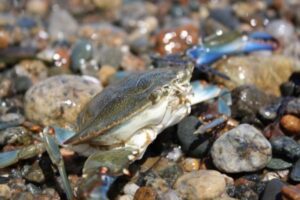Ocean Acidification Creating ‘Super-Sized’ Blue Crabs in the Chesapeake Bay

High carbon levels in the Chesapeake Bay are creating an imbalance among key species including oysters and blue crabs, reports the Washington Post.
The unusually high carbon levels have increased the size of the blue crab but slowed the size of the oysters, its primary food source. Carbon speeds the growth of crabs making them less vulnerable to predators while becoming more aggressive predators themselves.
The ocean acidification could continue to increase the crabs’ size over the next 75 to 100 years, and that could put pressure on the food chain as the crabs start to prey on other creatures in the Bay, and, reports the Post, “that would undermine an effort to rebuild the stocks of both creatures. Virginia and Maryland are pouring hundreds of millions of dollars into rebuilding the populations of blue crabs and oysters to some semblance of their historical numbers.”
Crabs in the Chesapeake Bay (along with lobsters and shrimp), grew nearly four times as fast when exposed to increased carbon levels. But oysters, scallops and other organisms struggled in those conditions, growing at just one-quarter the rate they grew in low carbon environments, according to the Post.
According to research on the issue, the high levels of carbon may actually confuse the crabs, making them eat less. But, as acidification happens over time, the crabs may adapt to the changes, becoming less confused and able to eat on par with their enormous size. But, for fans of crabmeat, it’s not a gain on the plate. The bigger size doesn’t impact the flesh, merely the animal’s shell.
Keep in touch with Jill on Twitter @jillettinger
Image: Sapienssolutions

